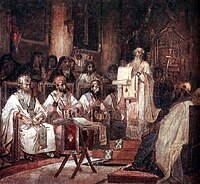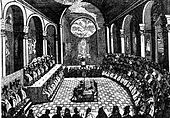
Back Tweede Konsilie van Konstantinopel Afrikaans مجمع القسطنطينية الثاني Arabic مجمع القسطنطينيه الثانى ARZ Conceyu de Constantinopla II AST Пети вселенски събор Bulgarian Concili de Constantinoble II Catalan Druhý konstantinopolský koncil Czech Andet koncil i Konstantinopel Danish Zweites Konzil von Konstantinopel German Ε΄ Οικουμενική Σύνοδος Greek
| Second Council of Constantinople | |
|---|---|
 Artistic rendition of Second Council of Constantinople by Vasily Surikov | |
| Date | 553 |
| Accepted by |
|
Previous council | Council of Chalcedon |
Next council | Third Council of Constantinople |
| Convoked by | Emperor Justinian I |
| President | Eutychius of Constantinople |
| Attendance | 152[1] |
| Topics | Nestorianism Origenism |
Documents and statements | 14 canons on Christology and against the Three Chapters. 15 canons condemning the teaching of Origen and Evagrius. |
| Chronological list of ecumenical councils | |
| Part of a series on the |
| Eastern Orthodox Church |
|---|
| Overview |
| Part of a series on the |
| Ecumenical councils of the Catholic Church |
|---|
 |
| 4th–5th centuries |
| 6th–9th centuries |
| 12th–14th centuries |
| 15th–16th centuries |
| 19th–20th centuries |
|
|
The Second Council of Constantinople is the fifth of the first seven ecumenical councils recognized by both the Eastern Orthodox Church and the Catholic Church. It is also recognized by the Old Catholics and others. Protestant opinions and recognition of it are varied. Some Protestants, such as Calvinists, recognize the first four councils,[2] whereas Lutherans and most Anglo-Catholics accept all seven. Constantinople II was convoked by the Byzantine Emperor Justinian I under the presidency of Patriarch Eutychius of Constantinople. It was held from 5 May to 2 June 553. Participants were overwhelmingly Eastern bishops—only sixteen Western bishops were present, including nine from Illyricum and seven from Africa, but none from Italy—out of the 152 total.[1][3]
The main work of the council was to confirm the condemnation issued by edict in 551 by the Emperor Justinian against the Three Chapters. These were the Christological writings and ultimately the person of Theodore of Mopsuestia (died 428), certain writings against Cyril of Alexandria's Twelve Anathemas accepted at the Council of Ephesus, written by Theodoret of Cyrrhus (died c. 466), and a letter written against Cyrillianism and the Ephesian Council by Ibas of Edessa (died 457).[4]
The purpose of the condemnation was to make plain that the Great Church, which followed a Chalcedonian creed, was firmly opposed to Nestorianism as supported by the Antiochene school which had either assisted Nestorius, the eponymous heresiarch, or had inspired the teaching for which he was anathematized and exiled. The council also condemned the teaching that Mary could not be rightly called the Mother of God (Greek: Theotokos) but only the mother of the man (anthropotokos) or the mother of Christ (Christotokos).[4]
The Second Council of Constantinople is also considered as one of the many attempts by Byzantine Emperors to bring peace in the empire between the Chalcedonian and non-Chalcedonian factions of the church which had been in continuous conflict since the times of the Council of Ephesus in AD 431.
- ^ a b "NPNF2–14. The Seven Ecumenical Councils, Introduction". CCEL. Retrieved 2014-08-23.
- (3 names, 3 bishops and 145 other, plus 1 pope, total 152)
- ^ See, e.g. Lutheran–Orthodox Joint Commission, Seventh Meeting, The Ecumenical Councils, Common Statement, 1993, available at Lutheran–Orthodox Joint Commission (B. I. 5a. "We agree on the doctrine of God, the Holy Trinity, as formulated by the Ecumenical Councils of Nicaea and Constantinople and on the doctrine of the person of Christ as formulated by the first four Ecumenical Councils.").
- ^ Cite error: The named reference
Catholicwas invoked but never defined (see the help page). - ^ a b Cite error: The named reference
Davis242was invoked but never defined (see the help page).